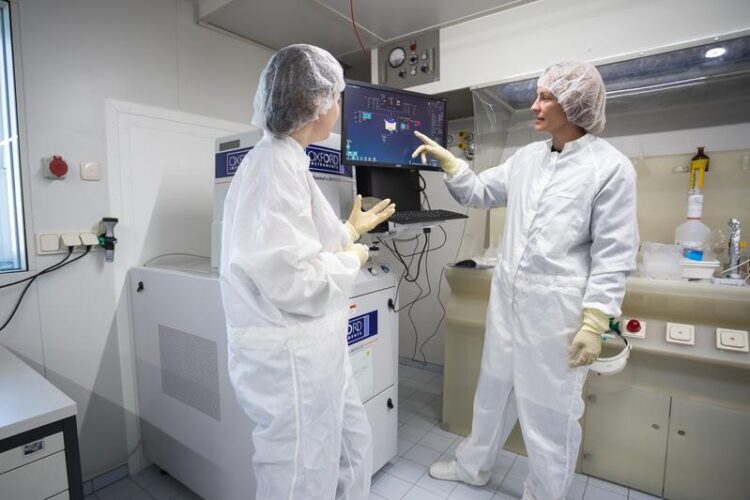Integrated light as a key to future computers

At TU Braunschweig, scientists etch porous semiconductor crystals made of gallium nitride with the utmost precision.
(c) Max Fuhrmann/TU Braunschweig
While computer chips are getting smaller and faster every year, one challenge remains unsolved: combining electronics and photonics on a single chip. Although components such as micro LEDs are available as individual chips and waveguides as tiny fibre optic cables, the materials required are too different for a harmonised chip. A new type of etching process could now be the decisive breakthrough for combining light sources and optical fibres. In the OptoGaN project, researchers from the TU Braunschweig and the Friedrich Schiller University Jena are therefore working on porous gallium nitride.
It will be particularly worthwhile for the strong German photonics industry to take a close look at Braunschweig and Jena over the next few years. The joint idea of the participating research groups offers a wide range of potential applications. The project partners want to realise three of these ideas as demonstrators together with one start-up each. These will then benefit technologies such as waveguides, neuromorphic computers and the Quantum Valley Lower Saxony‘s ion trap quantum computer. At the same time, the newly founded Nitride Technology Centre (NTC) at TU Braunschweig will support the further development of nitride technology at the highest level and bring it into application.
But what are the potential applications for this new technology? For example, quantum computers still need large laser systems to manipulate their ions. If more and more quantum bits are to be calculated together in the computer, this laser system must become significantly smaller – at best the size of a chip. However, the standard material silicon dioxide for waveguides on chips absorbs precisely the critical wavelengths of light. The porous gallium nitride could offer an alternative here and bring the customised light to the individual ion with minimal loss.
Complementary expertise in handling gallium nitride
The porous semiconductor is based on a new selective etching process. The researchers use it to create elongated, air-filled channels – pores – in the gallium nitride structures. This even makes three-dimensional waveguides with complex optical light guidance conceivable. As gallium nitride and the process are compatible with existing LED production methods, integrated electronic and photonic circuits will also be possible.
In order to realise the innovative semiconductor channels for light guidance, the researchers from Braunschweig and Jena are bringing together complementary expertise and special equipment. This is because the etching process used here has both an electronic and a chemical component. Firstly, the Braunschweig researchers produce the base material layer by layer. The semiconductor chip then travels to Jena for ion implantation. The researchers from Jena dope the chip and change its electronic properties in a targeted manner. Finally, the chip has to return to Braunschweig, where the chemical etching process forms the final, porous structure.
About the project
The project Highly integrated microphotonic modules in nitride technologies, OptoGaN for short, is being funded by the Federal Ministry of Education and Research with around 600,000 euros. The TU Braunschweig’s share of the funding amounts to 450,000 euros. The partners from Technische Universität Braunschweig and Friedrich Schiller University Jena started OptoGaN in 2023 for 3 years until October 2026.
Wissenschaftliche Ansprechpartner:
Prof. Dr. Andreas Waag
Spokesperson LENA-board
Technische Universität Braunschweig
Institute of Semiconductor Technology
Hans-Sommer-Straße 66
38106 Braunschweig
Phone: +49 531 391-3774
Email: a.waag@tu-braunschweig.de
www.tu-braunschweig.de/iht
www.tu-braunschweig.de/mib/lena
Weitere Informationen:
https://qvls.de/en/
https://www.tu-braunschweig.de/en/iht/research/research-projects
https://magazin.tu-braunschweig.de/en/pi-post/integrated-light-as-a-key-to-futur…
Media Contact
All latest news from the category: Information Technology
Here you can find a summary of innovations in the fields of information and data processing and up-to-date developments on IT equipment and hardware.
This area covers topics such as IT services, IT architectures, IT management and telecommunications.
Newest articles

Innovative 3D printed scaffolds offer new hope for bone healing
Researchers at the Institute for Bioengineering of Catalonia have developed novel 3D printed PLA-CaP scaffolds that promote blood vessel formation, ensuring better healing and regeneration of bone tissue. Bone is…

The surprising role of gut infection in Alzheimer’s disease
ASU- and Banner Alzheimer’s Institute-led study implicates link between a common virus and the disease, which travels from the gut to the brain and may be a target for antiviral…

Molecular gardening: New enzymes discovered for protein modification pruning
How deubiquitinases USP53 and USP54 cleave long polyubiquitin chains and how the former is linked to liver disease in children. Deubiquitinases (DUBs) are enzymes used by cells to trim protein…



